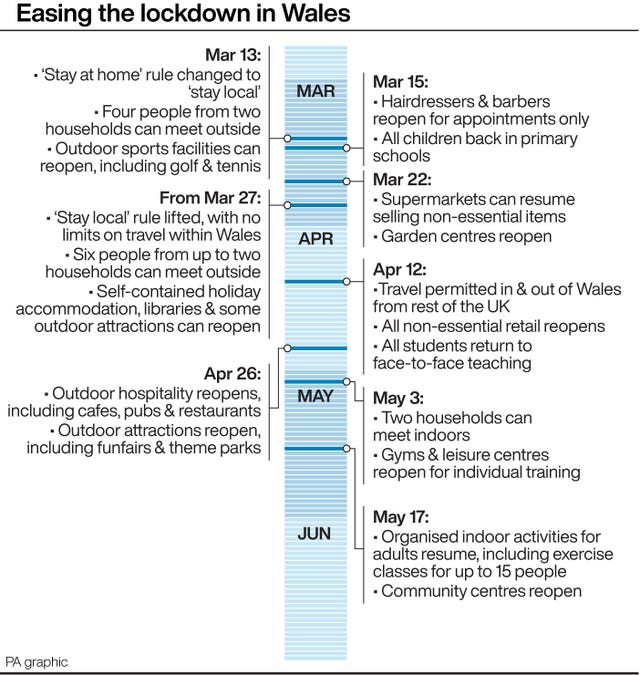A sharp drop in the number of Covid-19 infections in Wales has prompted the Welsh Government to ease some lockdown restrictions sooner than expected.
It comes on the back of the first round of easing in England and Northern Ireland which has allowed friends and family to meet in small groups outside.
Here’s what you need to know about the situation in each of the UK nations and what to expect in the coming weeks.
– What has changed in Wales?
The Welsh government announced on Thursday it had decided to lift restrictions on household mingling a week earlier than planned following a better-than-expected drop in cases from 37 to just 21 per 100,000 people.

The reopening of gyms and leisure centres has also been brought forward a week from May 10 to May 3, including for one-to-one training, although group exercise classes remain banned.
Organised outdoor activities for up to 30 people and wedding receptions for up to 30 people will be permitted outdoors from April 26 – again a week earlier than previously announced.
All dates are “subject to the public health situation remaining favourable” and will be confirmed at a review of coronavirus regulations on April 22, the Welsh Government said.
– Have all the plans changed?
No. The first round of easing is still due to start on Monday April 12, with the opening of close contact services and shops – completing a phased reopening of non-essential retail.
School aged-children are due to return to schools and colleges from the same date, with university campuses also reopening for a mix of both face-to-face and online learning.
As we prepare for more shops to open, let’s remember to keep Wales safe.
The @NHSCOVID19App is one of the ways you can help to protect yourself and the people you love.
Download it to help contain the spread of the virus.
— Welsh Government #KeepWalesSafe (@WelshGovernment) April 8, 2021
Restrictions on travel in and out of Wales are also set to be lifted, but people will not be able to journey to countries outside of the Common Travel area – the UK, the Channel Islands, the Isle of Man and Ireland – without a reasonable excuse.
The opening date for outdoor hospitality, including cafes, pubs and restaurants, remains unchanged on April 26.
The Government said previously it will make preparations so that whichever party leads the country after the May 6 Welsh Parliament election could consider allowing children’s indoor activities, community centres, and organised indoor activities for adults for up to 15 people to resume from May 17.
After May 17, considerations could be made to enable indoor hospitality and remaining visitor accommodation to reopen in advance of the spring bank holiday.
– What can people do in Scotland?
As of Good Friday, the stay-at-home order has been lifted across Scotland, allowing people to travel locally for non-essential purposes.
Last Monday, hairdressers and barbers reopened for pre-booked appointments, while click and collect shopping was again permitted, and homeware shops and garden centres began welcoming back customers.

Scotland is currently on course to ease restrictions further from April 26, and First Minister Nicola Sturgeon is due to give more detail in the coming weeks.
Under current plans, cafes, restaurants, shops and gyms are due to open, and more people will be allowed to meet up outdoors.
Libraries, museums and galleries, gyms and pools will also be allowed to open up.
– What is the lockdown situation in Northern Ireland?
As of April 1 in Northern Ireland, up to six people from no more than two households have been permitted to meet outdoors in a private garden.
Ten people, from no more than two households, are able to participate in outdoor sporting activities.

-What is the picture in England?
As of March 29, rules in England were eased to allow groups of up to six people, from any number of households, or a group of any size from up to two households, to gather in parks and gardens
The Government’s “stay at home” order was replaced with “stay local” and people are still asked to work from home where possible, and overseas travel remains banned.

– When will more restrictions be eased in England?
From April 12 at the earliest, shops, hairdressers, nail salons, libraries and outdoor hospitality venues such as beer gardens will be allowed to reopen.
Most outdoor attractions, such as zoos and theme parks, can reopen, although wider social distancing rules will still apply to prevent indoor mixing between different households.
Indoor leisure facilities such as gyms and swimming pools will also be opened but for use by people on their own or in household groups.
Funerals can continue with up to 30 people, and the numbers able to attend weddings, receptions and commemorative events such as wakes will rise from six to 15.
– What happens next in England?
From no earlier than May 17 most social contact rules outside will be lifted, although gatherings of more than 30 will remain illegal.
Indoors, the rule of six or two households will apply – although the Government has said it will keep under review whether it is safe to increase this.

Limited crowds will also be allowed at sporting events.
All remaining restrictions on social contact could be lifted from June 21, allowing for larger events to go ahead and nightclubs to reopen.
– How is the Government deciding when to lift restrictions in England?
There will be a minimum of five weeks between each step of easing restrictions in England to allow for coronavirus-related data to be assessed against four tests:
1. The vaccine deployment programme continues successfully.
2. Evidence shows vaccines are sufficiently effective in reducing the number admitted to hospital and deaths in those vaccinated.
3. Infection rates do not risk a surge in hospital admissions, which would put unsustainable pressure on the NHS.
4. The assessment of the risks is not fundamentally changed by new variants of concern.






